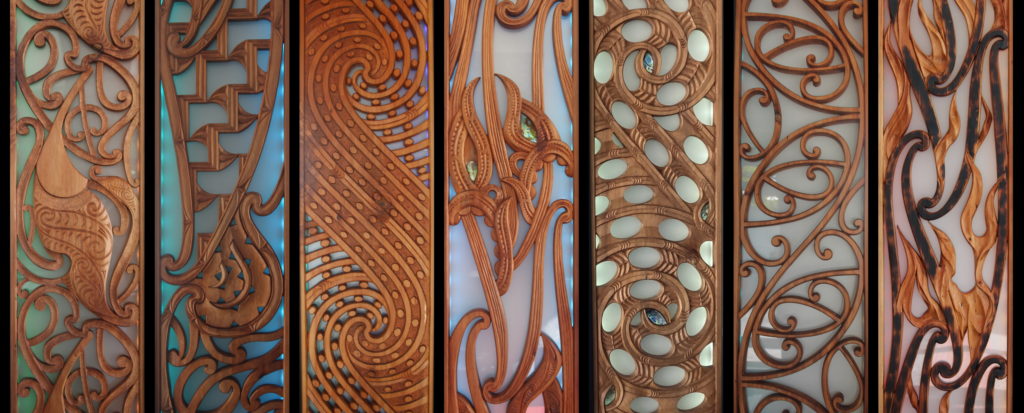
In July 2022, Carey had the honour and privilege of unveiling our newly installed whakairo carvings in Te Whare Oranga at a dawn service. The seed of an idea was planted some years ago and has now flourished into these beautiful panels and poupou carved by Peneamine Werohia. We are so grateful for the level of care and craftsmanship Pene put into these pieces. They eloquently tell the story of Carey, and the values that shape us as a learning community that forms leaders who are marked by a deep love for Jesus, his word, his church, and his mission.
These carvings are on permanent display, so be sure to stop by and see them next time you are on campus.

Te Taro o Te Ora
The Bread of Life
Ko tēnei hoahoa he hoahoa tohu i ā te taro . He kai motuhake tēnei mea te taro. Nā ō mātou tūpuna tēnei kai i kawea mai i Hawaiki rānō. Inā hoki, he tohu whakamahara, whakanui tēnei hoahoa i a Ihu. Hei tāna, hei tā Ihu, “Ko ahau te taro o te ora ki te haere mai tētahi ki ahau, e kore rawa ia e hiakai’ (Hoāni 6:35). Ngā tohu whakairo – Ko te Koru, te Puhoro, te Pākati me te Aramoana te tāhuhu o te kōrero e mea ana, ‘e ora tonu te kupu, e mana tonu te kupu’ (Hīperu 4:12).
This design symbolises the taro plant which Māori originally brought from Hawaiki as one of their staple foods to sustain life. It represents Jesus, the Bread of Life. Jesus said, “I am the bread of life. Whoever comes to me will never go hungry.” (John 6:35). Jesus is also the Word of God, the One to whom the Scriptures bear witness. The carving patterns – Koru, Puhoro, Pākati and Aramoana – support the representation of the word as “living and active” (Hebrews 4:12).

Te Haerenga
The Journey
Ko ngā rāwhara o ngā waka hourua te whakairo nei ā ka tae mai te Māori ki Aotearoa mā runga i aua waka. E tohu ana ngā rāwhara i ngā tauira nō ngā hau e whā me te ara mātauranga i whaia e rātou. Ko te whakairo Ritorito he tohu mō te whāngai, he tohu hoki mō ngā mahi whakatupu. Ko te Kākahi Whakairoiro o te Moana, he tohu tēnā mō te mana o ngā rangatira. Ko te Puhoro me te Mangopare ngā tohu mō te hau o te wairua e puhia ana i te rāwhara e tū nei. Ko te Pākura me te Ara Poutama he tohu mātauranga, he tohu piki taumata. Kei te tihi o te whakairo nei te Unaunahi. He tohu tēnei mō Io Matua Kore.
This design resembles the sails of the various voyaging waka on which Māori sailed to Aotearoa. The four sails symbolise the different ethnicities and cultures of our students and the journey of discovery they experience during their training. The Ritorito pattern bordering each of the sails symbolises nurture and growth. Te Kākahi Whakairoiro o te Moana pattern symbolises the mana of chiefs. The Puhoro and Mangopare patterns represent the wind of the Spirit filling the raised sails. The Pākura and te Ara Poutama patterns represent the journey to heavenly wisdom. At the highest level, with the Unaunahi or fish scale pattern, is Io Matua Kore, the Uncreated One, Creator of all things.

Te Tuku Mātauranga
The Passing on of Knowledge
Ko te kauae runga me te kauae raro ngā tohu o tēnei whakairo. He mea kitea mā roto mai i ngā Kape Rua me ngā whakarei Unaunahi. Hei tā ngā tikanga o te ao Māori, koia tēnei te tohu o te rironga atu o te mātauranga ki a Māui. He mātauranga i takea mai i tōna kuia a Taranga. Nā konei a Māui hī ake i te ika nui, i te ika roa, i te Ika-a-Māui. Ko te mātauranga o runga tēnei whakairo (Hēmi 3:17). Ko te whakatinana mai ki raro anō hoki.
This double interlocking hook design, using the Kape rua and Unaunahi patterns, symbolises top and lower jaw bones. In te ao Māori, it represents the celestial knowledge and earthly knowledge passed down to Māui by his grandmother Taranga. With this knowledge Māui fished up the North Island, Te Ika a Māui. The design represents the teaching of “the wisdom that comes from heaven” (James 3:17), and its application in our lives and communities here on earth.

Ngā Hau e Whā
The Four Winds
E tohu ana tēnei hoahoa i te tūātea o te moana. Nā te pupuhi o te hau, te rū o te whenua, te pahū mai o te puia hoki, kite ake ai tēnei tohu o te Puhoro . Ki te whakamahia rānei i tō hoe ka kite koe. Kei runga i te waka taua, kei ngā kūhā o te toa ā kei runga i te whare tūpuna anō hoki taua whakairo . Ko te tere, te kaha, te maia me te moruki hoki ōna tohu. E tu ana te Manaia ki tōna taha hei tohu i te ao wairua. Ko ‘Ngā Hau e Wha’ tēnei taonga arā ko te whaitua o te Atua. Ko tētahi tikanga hoki, ko te manawa o te Atua ko te wairua o te Atua rānei, nāna nei i whakamana i te tangata hei mahi i āna mahi (Ngā Mahi 1:8).
This pattern resembles breaking waves created by winds, storms, earthquakes, volcanic eruptions, or the wake created by a waka or by the action of paddles. Puhoro, seen on waka prow and the thighs of warriors and rafters, symbolises speed, power, strength, and agility. Coupled with the Manaia forms that symbolise the spiritual realm, this design represents the four winds or the four corners of the earth – the domain of God’s mission. It can also mean the breath of God or the Spirit of God, the One who empowers God’s people for mission (Acts 1:8).

Te Marama o Te Ao
The Light of the World
Ko Ranginui rāua ko Papatūānuku me a rāua tamariki te whakairo nei. Kei waenga pū ko Io Taketake, te kaihanga o ngā mea katoa. Ko te wāhi āputa nei he tomokanga kia uru mai te mārama ki te ao. I roto i te pōuri te mārama e whiti ana ā ko Ihu tērā. Ka mea a Ihu ‘Ko ahau te whakamārama o te ao: ki te aru tētahi i ahau, e kore ia e haere i te pōuri, engari ka whiwhi ki te mārama o te ora ’ (Hoani 8:12).
The double open spiral design symbolises Ranginui and Papatūānuku and their children, or heaven and earth and all creation. Io Matua Nui, the Creator, is represented by the paua eye at its centre. The open spaces between the double spirals symbolise the entrance of light into the world. Jesus, who came as light into the darkness, said, “I am the light of the world. Whoever follows me will never walk in darkness, but will have the light of life” (John 8:12).

Te Akaaka Pono
The True Vine
He kowhaiwhai tēnei hoahoa. Ka kite koe i ngā heke o te whare. He oranga hou tōna kōrero, he tohu tēnei mō te whāngai, te tupu, te whakapapa. He mea whakatupu, whakahua, whakapuāwai hoki i te tangata. Ko te manawa me te koru tōna āhua ā ka whakaata mai i a ia anō, haere ake nei. He akaaka tēnei. Ko Ihu te aka matua, ko tātou ngā peka whai hua. Ka mea a Ihu ‘Ko au te waina pono … ko koutou ngā manga: ki te ū tētahi ki roto ki ahau, me ahau hoki ki roto ki a ia, ka maha o tērā hua: ki te motu kē hoki i ahau, e kore tētahi mea e taea e koutou’ (Hoani 15:1, 5).
This is a kowhaiwhai rafter design which symbolises new life, nurture, growth, whakapapa, self-reflection, and flourishing. It is made up of a main manawa or heart line, and koru that branch off, repeat and reflect on themselves. This design represents a vine, with Jesus as the main manawa line, or the true vine, and us as the branches flourishing and bearing much fruit as we remain in him. Jesus said, “I am the true vine … you are the branches. If you remain in me and I in you, you will bear much fruit; apart from me you can do nothing” (John 15:1, 5).

Te Pou Ahi
The Pillar of Fire
E pāhekoheko ana te Puhoro rāua ko te ahi. Ko te Puhoro te tohu mō te hau. He tohu mō te tere, te kaha, te maia anō hoki. Tūhono mai ki te ahi ā ko tahi te kōrero, ko te kaha o te wairua tapu (Ngā Mahi 2:3) me āna mahi hei whakanoa, hei whakatapu i a tātou anō. (Matiu 3:11; Ruka 24:32).
The combination of the Puhoro design, which can symbolise wind, speed, power, and strength, together with the flame design, represent the presence and power of God the Holy Spirit (Acts 2:3). They also signify the cleansing and purifying work of the Spirit of Jesus in our lives (Matthew 3:11; Luke 24:32).
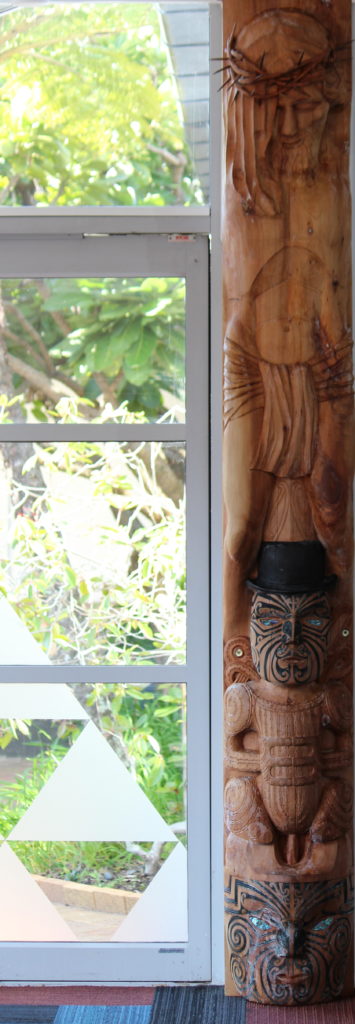
Te Timatanga
The Beginning
‘Koia anō te aroha o te A tua ki te ao, homai ana e ia tana Tama kotahi, kia kore ai e ngaro te tangata e whakapono ana ki a ia, engari kia whiwhi ai ki te ora tonu.’ Hōani 3:16
He Pou mahara tēnei. I te tau 1882 i poupoua te mahi i waenga i te iwi o Tūhourangi ki Te Wairoa. I te tau 1886 ka pahū a Tarawera. Mōtītī ana te Wairoa, hinga atu ana ngā tāngata nō reira. Kotahi rau, rua tekau ngā tāngata i mate atu, he Māori te nuinga. E whakakōrero ana tēnei pou i te wharenui e kiia nei ko Hinemihi. I taua wā i Te Wairoa, tū māro ana te whare. He whare whakaruruhau mō te hunga e uru atu ki te poho . E whā tekau mā rima ngā mōrehu. Ko Tene Waitere nō Ngāti Tarāwhai rāua ko Wero Taroi ngā kaiwhakairo o Hinemihi. Ko Taratara-ā-Kae te tauira matua o tēnei pou. He hoahoa rongonui i te takiwā o Ngāti Tarāwhai. Ko Ihu, ko Tarāwhai, ko Tūhourangi anei e tū ake nei.
“For God so loved the world that he gave his one and only Son, that whoever believes in him shall not perish but have eternal life.” John 3:16
This poupou recalls the first Baptist Maori mission established in 1882. The work was centred at Te Wairoa, gateway to the famous pink and white terraces, amongst the Tuhourangi people of Te Arawa in the Rotorua region. The Tarawera eruption in 1886 destroyed Te Wairoa and killed some 120 people, most of whom were Maori. Some 45 people, however, were saved when they took shelter in Hinemihi, the meeting house that once stood at Te Wairoa. This poupou is based on that meeting house. Hinemihi was carved by Tene Waitere o Ngati Tarāwhai and Wero Taroi. Like all meeting houses, it represents the people. Taratara-ā-Kae is a popular pattern among Tarāwhai carvers and used extensively on these carvings. Below the carving of Jesus on the cross, is Tarāwhai and below him is Tūhourangi.
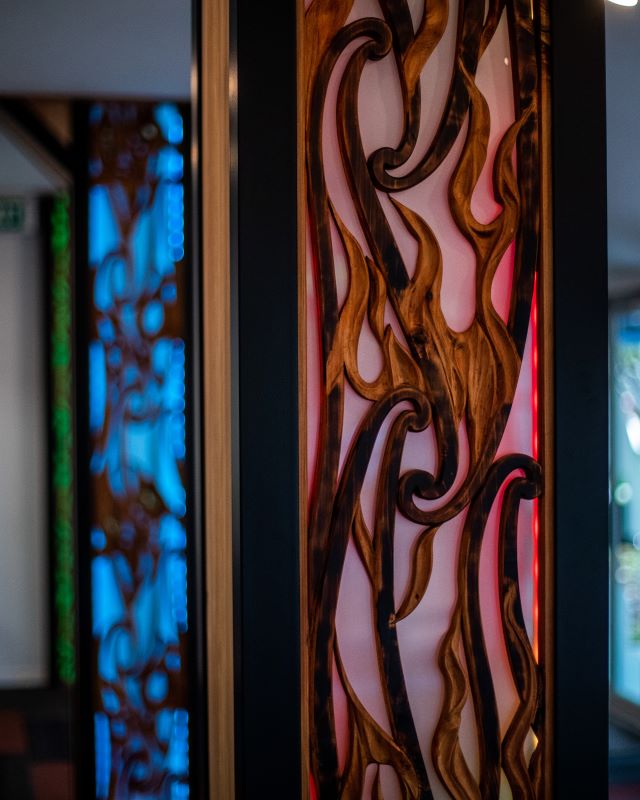
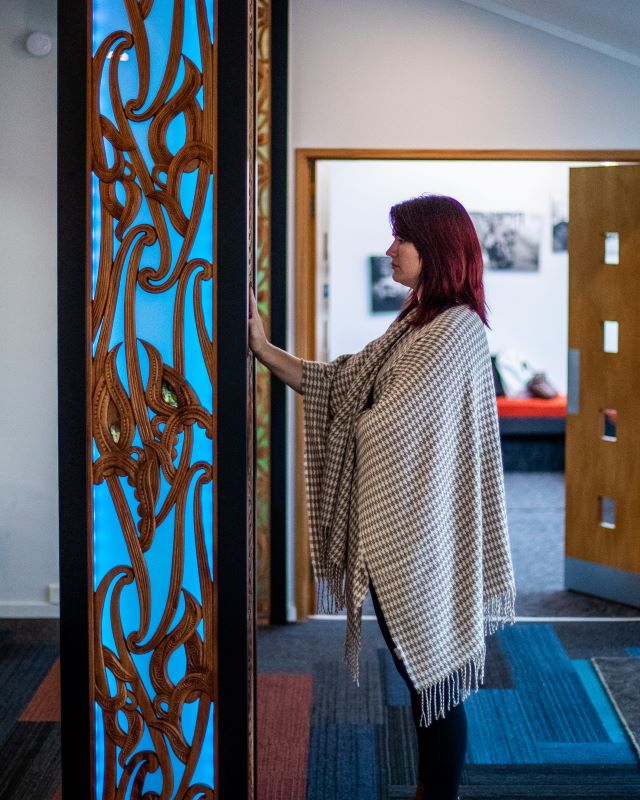
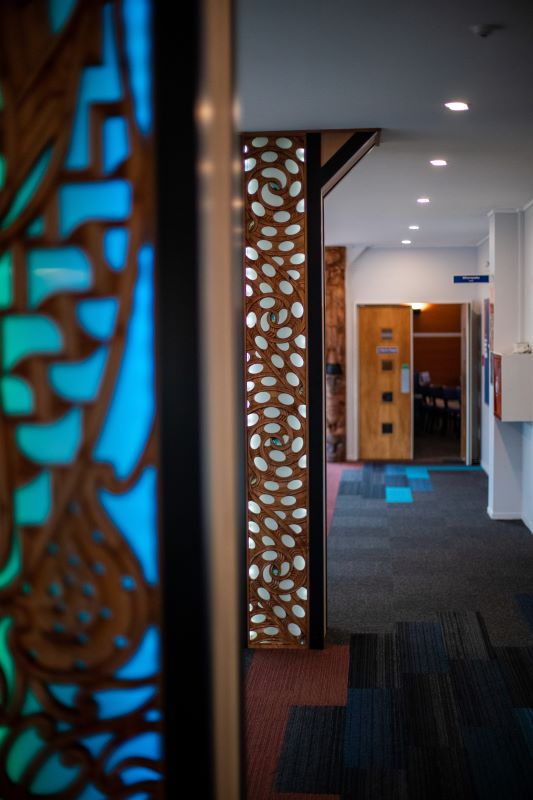
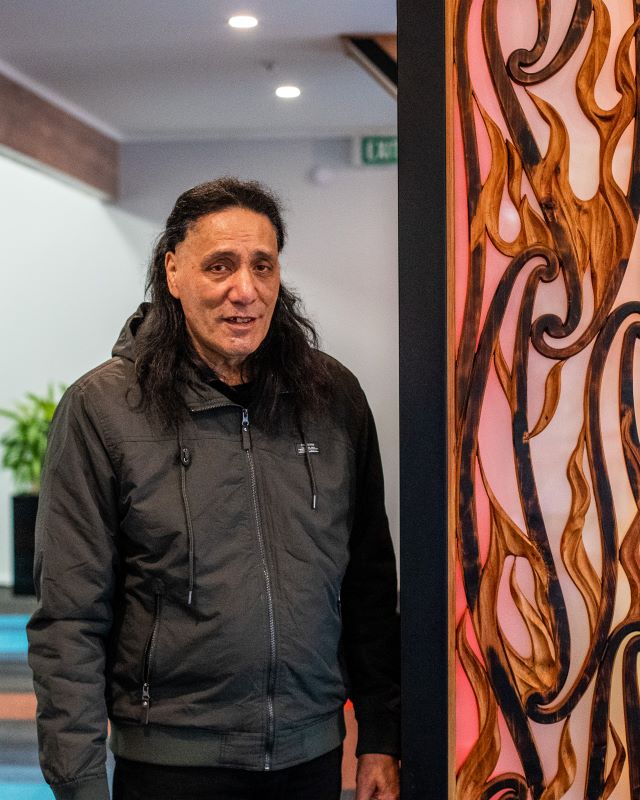
Ngā Hau e Whā – The Four Winds
The whakairo carvings leading into Carey’s Chapel
Peneamine Werohia – Master Carver

Brilliant. What a great way to show the meanings of these beautiful tāonga.